Derry, also known as Londonderry, is Ireland’s only fully intact walled city, rich in history and culture. Despite its burdensome past, marked by events such as Bloody Sunday, visiting Derry offers many surprises, as there is plenty to see. The city is also the perfect starting point for the Causeway Coastal Route, and in this article, you will discover its highlights.
and save on walking tours and museums tickets
Table of Contents
Derry or Londonderry: Why the City Has Two Names
Before talking about what to see in Derry, it’s worth making a premise about the city’s name. You’ll see it spelt in two different ways, Derry or Londonderry, and the choice is never random.
PLAN YOUR TRIP TO NORTHERN IRELAND
Stay connected in Northern Ireland with a giffgaff free SIM or an Airalo eSim for data coverage that works seamlessly throughout the whole UK. Plus, dive into everything you need to know about renting a car in Ireland, so you can easily explore incredible attractions like the Giant’s Causeway.
The choice between reflects the city’s history and the political sentiments in Northern Ireland. This naming decision is still a topic of ongoing debate. Using the incorrect name can even offend its residents!
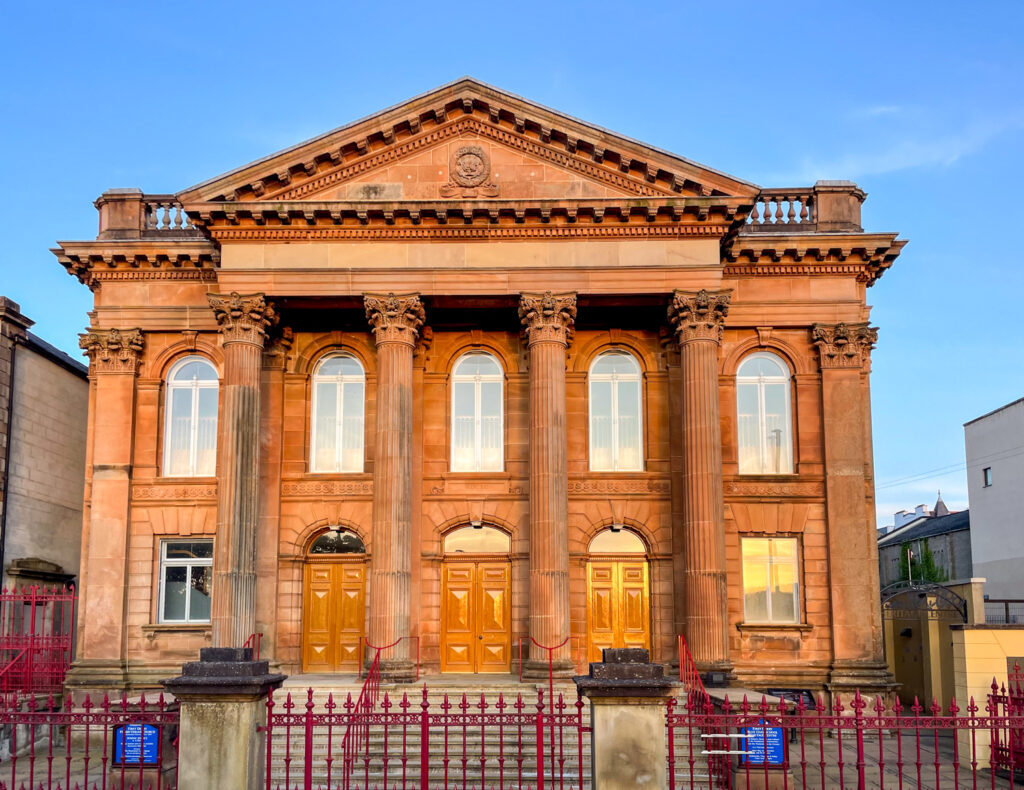
Origins of the Names Derry and Londonderry
Historically, the name Derry came from the Irish “Doire”, meaning “oak grove”. It has been used informally for centuries and is often preferred by nationalists and those who identify with the Catholic community.
On the other hand, Londonderry was officially designated in the 17th century when the city was granted a charter from King James I. This name reflects the influence of Protestant settlers from England. Unionists and the Protestant community adopted the name Londonderry.
Which Name to Choose: A Political Issue
The dual naming has significant implications. For many, the choice between Derry or Londonderry symbolises deeper political and cultural affiliations. It reflects the ongoing tension in Northern Ireland’s identity, particularly about the broader historical context of British-Irish relations.
Nationalists who prefer Derry view the name Londonderry as an imposition of British colonialism. At the same time, unionists who use Londonderry see it as a recognition of the city’s heritage and historical ties to Britain.
Recently, local authorities and organisations have adopted a more flexible approach. You can see often both names or Derry-Londonderry, attached with a dash or a hyphen. The city’s signage can reflect this duality, such as on official documents or tourism materials.
However, this compromise didn’t erase the underlying conflict around the names, which can still elicit strong reactions! Ultimately, choosing between Derry or Londonderry can evoke different historical narratives.
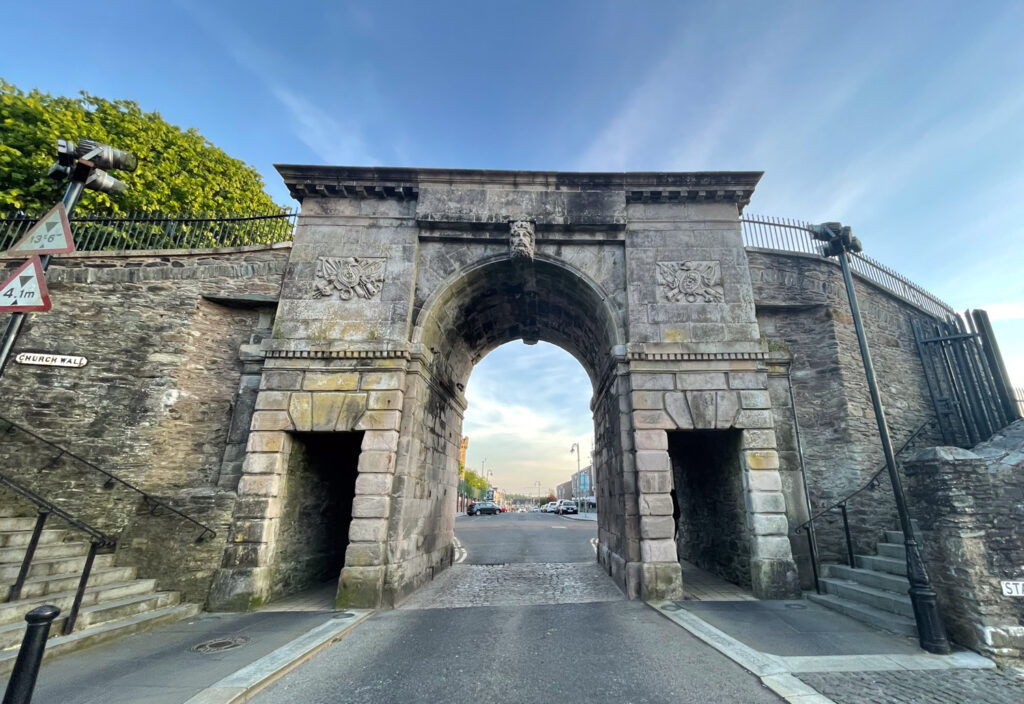
Things to do in Derry-Londonderry
A part for its recent past, Derry is renowned for its iconic 400-year-old walls. From a stroll around these historic ramparts, you can enjoy a unique perspective on the city’s past and the stunning views of the surrounding landscape.
Along the way, you’ll encounter various landmarks, including the Guildhall, a significant part of Derry’s heritage since 1887. You can also delve deeper into Derry’s history by visiting the Tower Museum. There, you can learn about the city’s journey from its early beginnings to the Troubles.
If you’re a fan of the popular TV series Derry Girls, plenty of tours and experiences are available. On the other hand, the Museum of Free Derry offers a poignant experience focused on the civil rights movement and Bloody Sunday.
But there is so much more to explore, so keep reading!
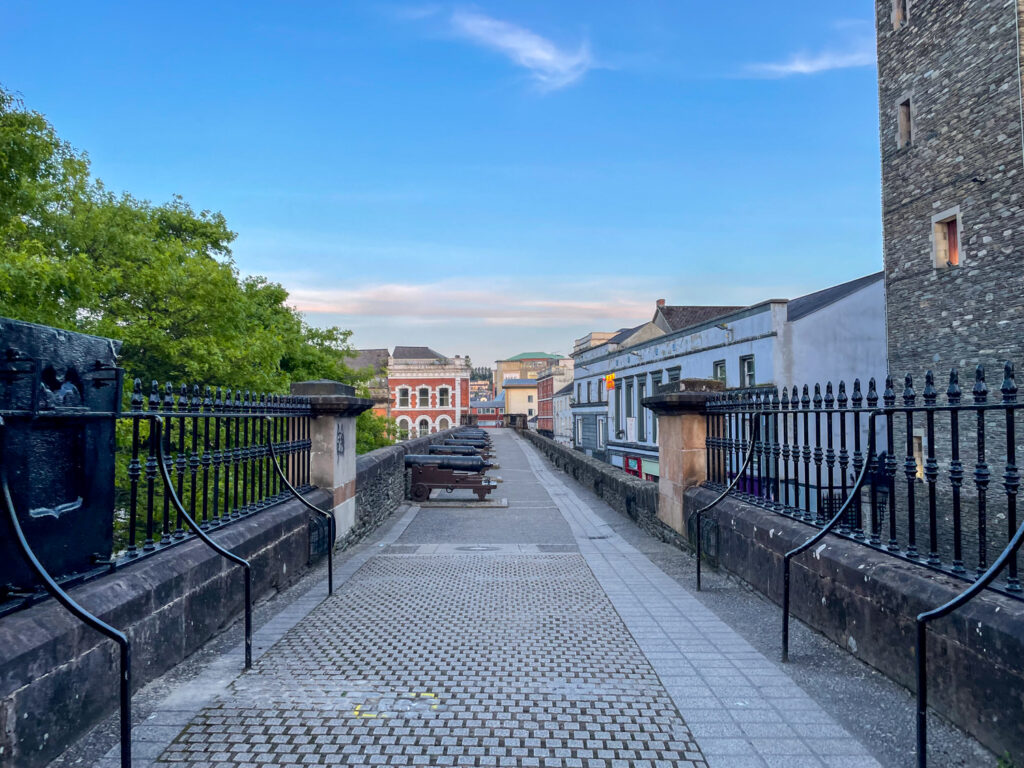
The Historic Walls
Derry has the most complete circuit of historic walls of any town in Northern Ireland, and these walls are among the best-preserved in Europe. They stand up to 26 feet high and stretch almost 1 mile in circumference.
The walls were constructed in the early 17th century to protect Protestant English and Scots settlers who were established here as part of the Plantation of Ulster.
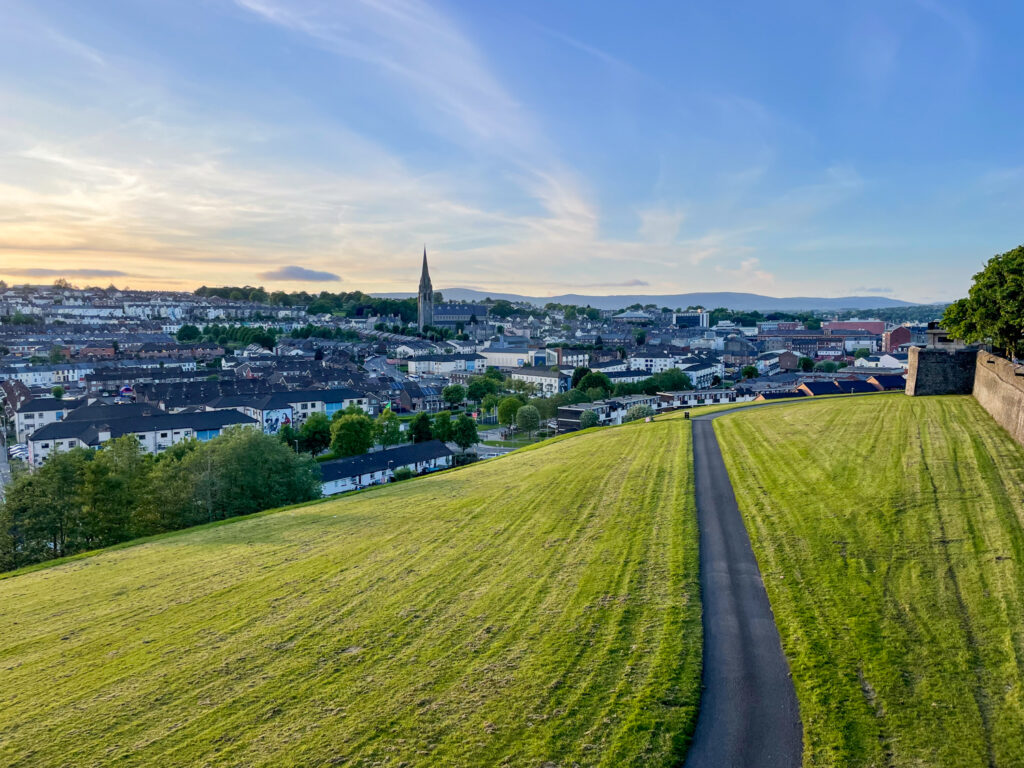
King James I encouraged loyal subjects to move to this area to bring the rebellious Gaelic regions under the control of the English crown. The City of London, through The Honourable Irish Society, provided financial support to manage the plantation and facilitate the construction of the walls.
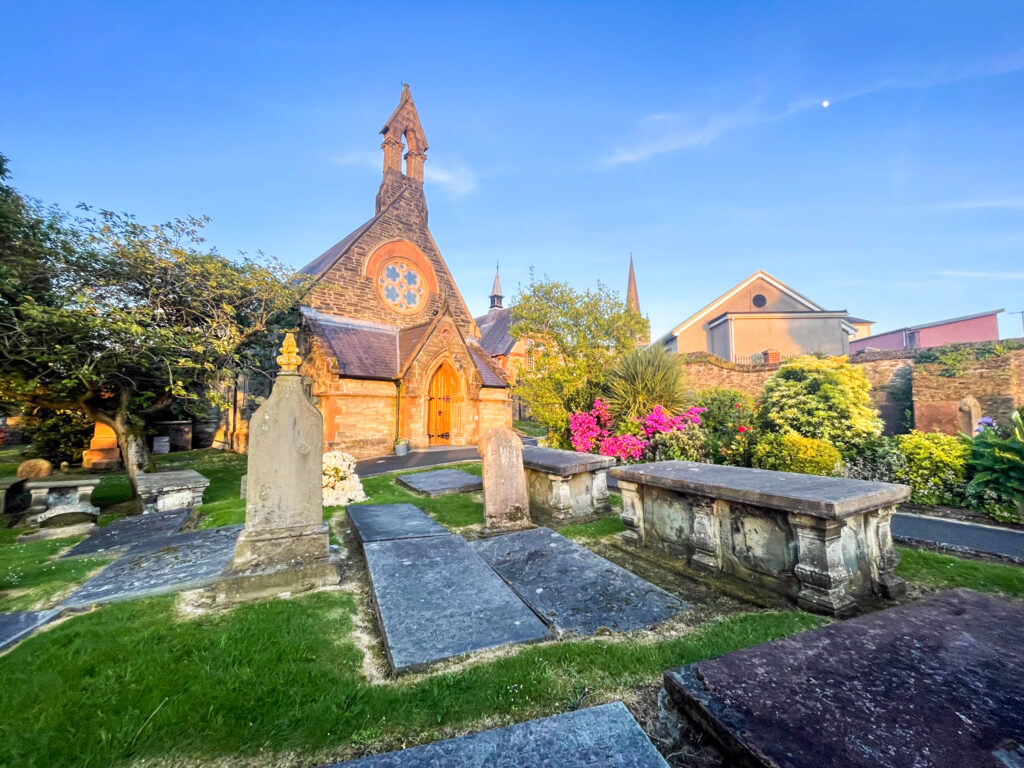
As you can see, the conflicts between Protestants and Catholics in Northern Ireland are not a recent phenomenon; these stone fortifications narrate stories of historic sieges and disputes that date back centuries.
Walking along the walls, you can see various gates, cannons, bastions, and a church. The view of the city and its surroundings is really stunning!
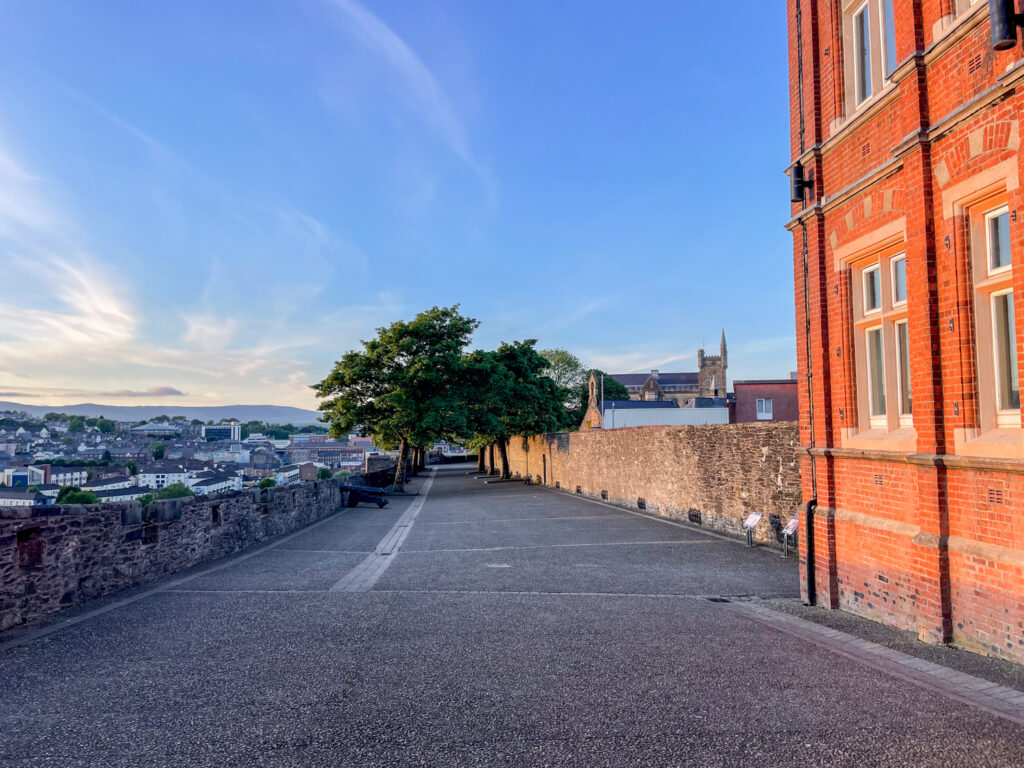
The Guildhall
The Guildhall is an iconic Victorian building in Derry, recognised as a Grade A listed structure for its special architectural and historic interest. It’s truly imposing, and you shouldn’t miss it.
Many famous individuals have visited the Guildhall, too. Shortly after her coronation, Queen Elizabeth II and Prince Philip visited Guildhall Square in 1953. In 1955, the Guildhall served as the backdrop for a key address by US President Bill Clinton during his visit to Northern Ireland.
Built in 1887, it features an eclectic style described as neo-Gothic with Tudor overtones. The Guildhall boasts the second-largest clock face in the British Isles and contains some of the finest examples of stained glass windows in the country. The Honorable Irish Society financed it, and it was initially named ‘Victoria Hall’ in honour of the reigning monarch.
During The Troubles, the Guildhall was the focus of multiple terror attacks. In 1972, the building was hit twice by terrorist bombs, causing significant damage to the structure, the organ, and the statue of Queen Victoria. Additionally, from 1998 to 2005, the families of Bloody Sunday gathered in the Guildhall for the publication of the Saville Report findings.
Today, the Guildhall is open Monday to Friday from 09:00 to 20:00 and on Saturdays from 09:00 to 18:00, with free entry. Guided tours are available, but you must book in advance, and they cost £3.00 per person. The tour is free with the Visit Derry Pass.
Guildhall
Guildhall Street, Derry BT48 6DQ
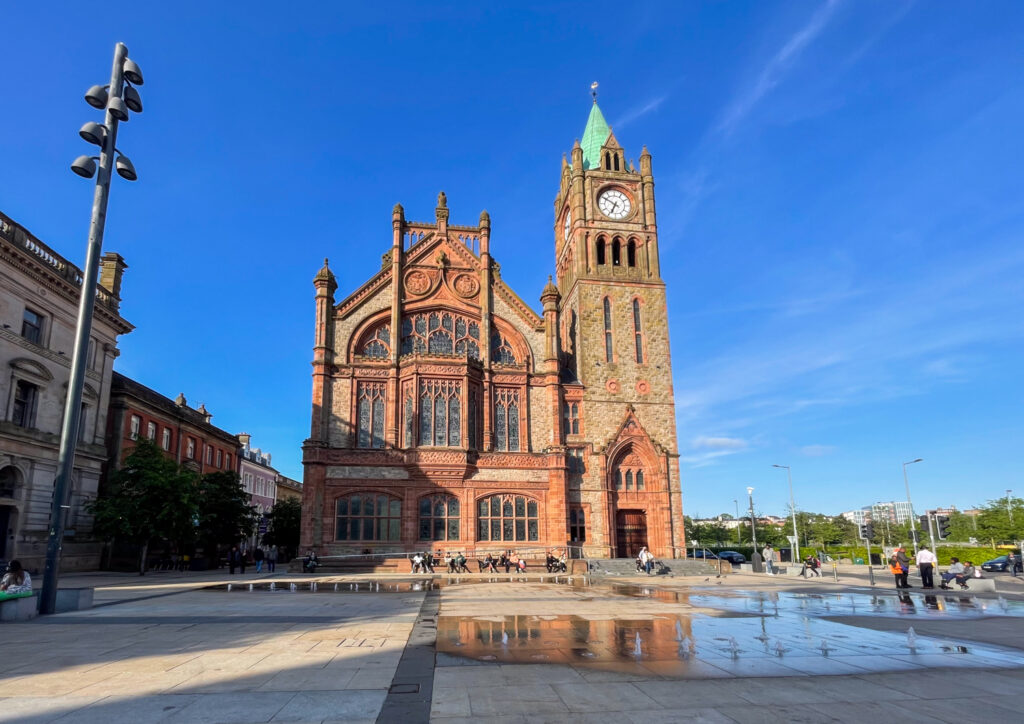
The Craft Village
The Craft Village, located within historic walls, is a reconstruction of an 18th-century street and a 19th-century square. It’s an eclectic mix of artisan shops, balconied apartments, licensed restaurants, and coffee shops. It also serves as a cooperative enclave that showcases local artisan crafts.
I really enjoyed wandering through its streets. Though it has just two blocks of houses, it is pretty beautiful. Unfortunately, only a few shops were open on the day of my visit.
Shopping in the Craft Village is not cheap, but with over seventy local crafters working there, it’s the perfect destination to discover unique, handcrafted gifts.
The Craft Village
Shipquay Street, Derry BT48 6AR
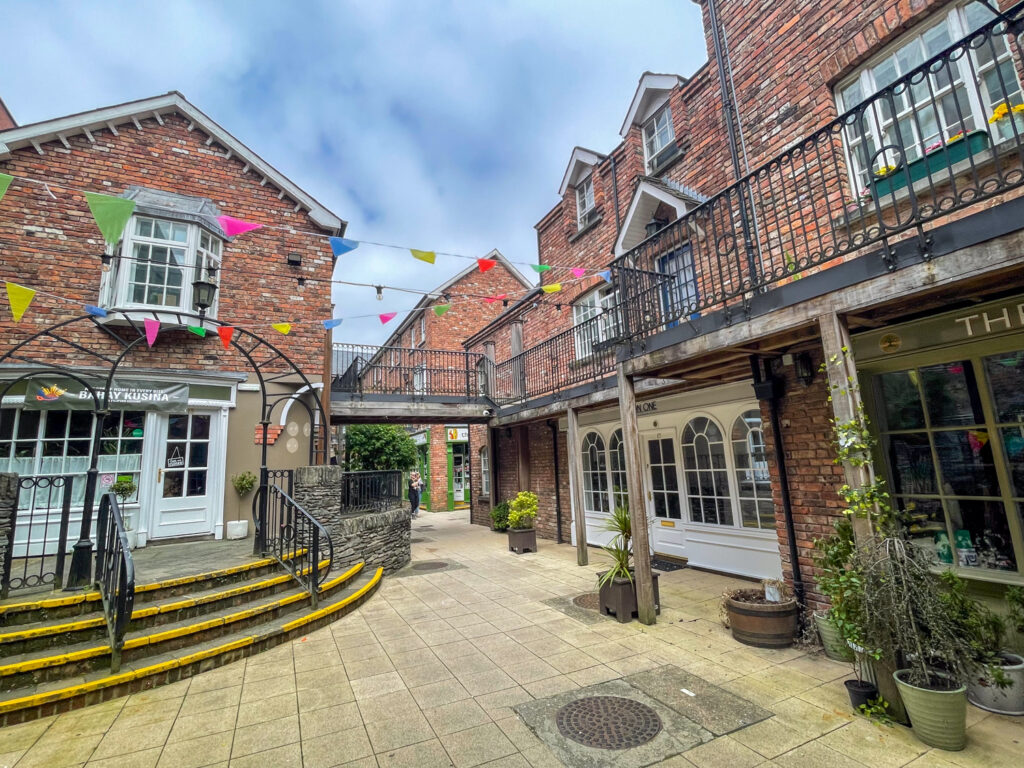
The Tower Museum
The Tower Museum is in the centre of the old city, near the Guildhall. It covers Derry’s past, from its early origins to its significant role during the Troubles.
The museum features two permanent exhibits: The Story of Derry, which presents the city’s history from its prehistoric origins to the present, including the political conflicts. The other exhibit is An Armada Shipwreck – La Trinidad Valencera, which details the local shipwreck from the Spanish Armada.
Opened in 1992, the museum has received several awards. I haven’t visited the Tower Museum yet, but I read the exhibits should be both informative and engaging, offering a deep understanding of the city’s heritage. I hope to visit it on my next trip to Derry because it seems really interesting.
The Siege Museum
The Siege Museum and Exhibition features a permanent display dedicated to the history of the Siege of Londonderry and the associated clubs of the Apprentice Boys of Derry.
You should know that the Siege of Londonderry in 1689 was a significant event in British and Irish history. For 105 days, up to 30,000 Protestant residents defended the walled city of Londonderry against the Catholic King James II. The Siege ended when a relief fleet broke through the boom across the River Foyle on July 28, leading to the retreat of the Jacobite forces on August 1, 1689.
Following the Siege, the first Apprentice Boys Club was established in 1714 by Colonel John Mitchelburne, the City’s Governor at the time. Although this club ceased to exist after his death, the memory of the Siege was commemorated annually throughout the 18th century.
In 1814, Benjamin J. Darcus founded the Apprentice Boys of Derry Club. Over the next 40 years, several other clubs were formed to honour the heroes of the Siege, remembered as the ‘Loyal Orders’. Each order has its dedicated room in the Siege Museum, including the Apprentice Boys of Derry, the Orange Order, the Women’s Orange, and the Royal Black Institution.
The Siege Museum
13 Society Street, Derry BT48 6PJ
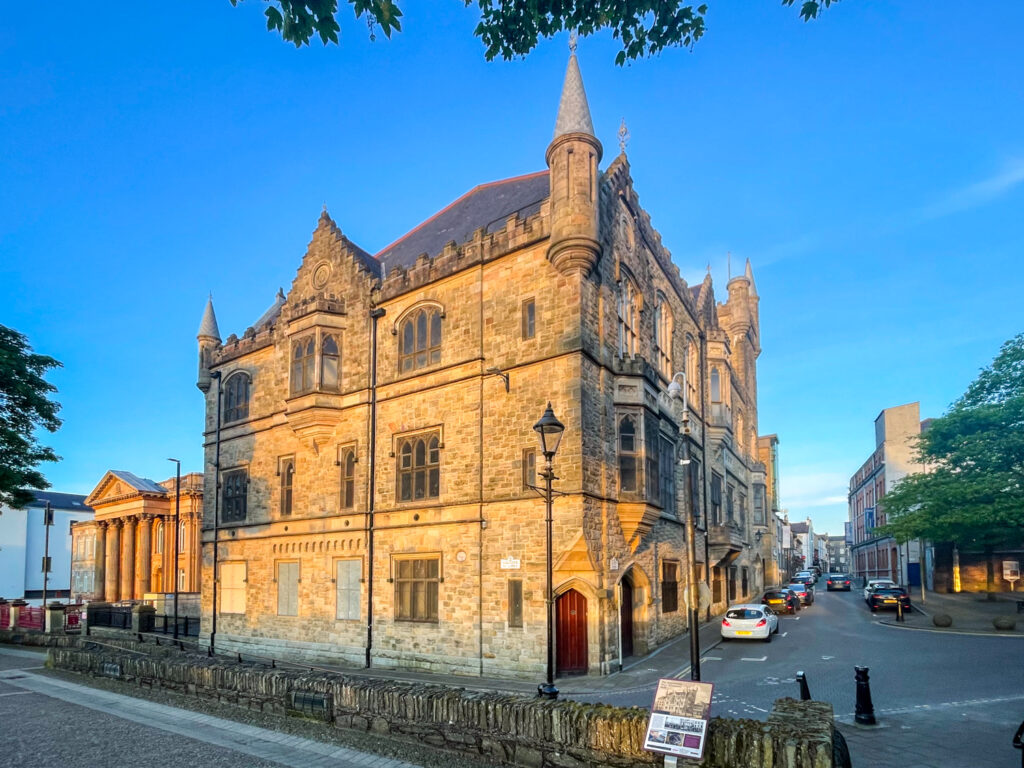
The Derry Girls Experience
If you’re a Derry Girls series fan like me, you’ll love discovering where it all began. In Derry, you can visit a permanent exhibition and participate in a guided tour. You can also see some locations at the Ulster Folk Museum, just a few miles outside the city!
At the Tower Museum, you can explore The Derry Girls Experience, an exhibit run by Visit Derry that allows you to step onto the set of the Quinn household and feel like a part of the family. You’ll see original memorabilia from the hit show, such as Erin’s diary, Aunt Sarah’s pyjamas, and Ma Mary’s Woolworth’s sweater, as well as the Spice Girls costumes.
The Derry Girls Experience
Tower Museum, Union Hall Place, Derry BT48 6LU
In the city, you can find the iconic Derry Girls mural on the side of Badger’s Bar, and you can join a Derry Girls tour. During the tour, your guide provides background information about the famous mural and discusses the similarities and differences between Catholics and Protestants.
The Derry Girls tours include visits to Pump Street, the Guildhall, where Bill Clinton visited and Orla registered to vote, and many other notable sights and stories.
During the tour, the guide shares insights and anecdotes about the show, including behind-the-scenes stories, upcoming news, and local Derry Girl humour.
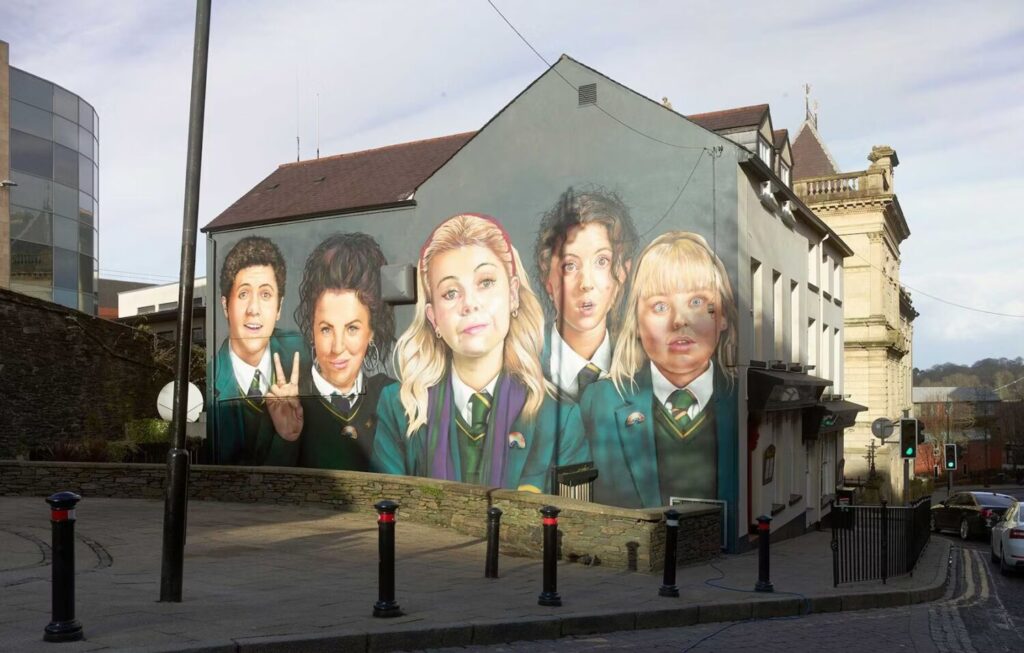
The Museum of Free Derry
The Museum of Free Derry was one of the main reasons I wanted to visit Derry, and it left a strong impression on me. It is challenging to describe the experience of visiting this museum, which tells the story from the perspective of Northern Irish Catholics and the violence they suffered at the hands of the British police.
The museum offers detailed context and personal narratives to help foreign visitors understand what was essentially a recent civil war in the heart of democratic Europe, leaving plenty of room for reflection, as you can read on my article about the Museum of Free Derry.
Located in the Bogside Catholic district, the Museum of Free Derry focuses on the civil rights movement of the late 1960s, which led to The Troubles and the Free Derry Irish nationalist movement in the early 1970s. It showcases photographs, posters, film footage, letters, and personal objects. The museum is powerful and emotional, detailing the civil rights struggle and the legacy of Bloody Sunday.
Museum of Free Derry
55 Glenfada Park, Bogside, Derry BT48 9DR
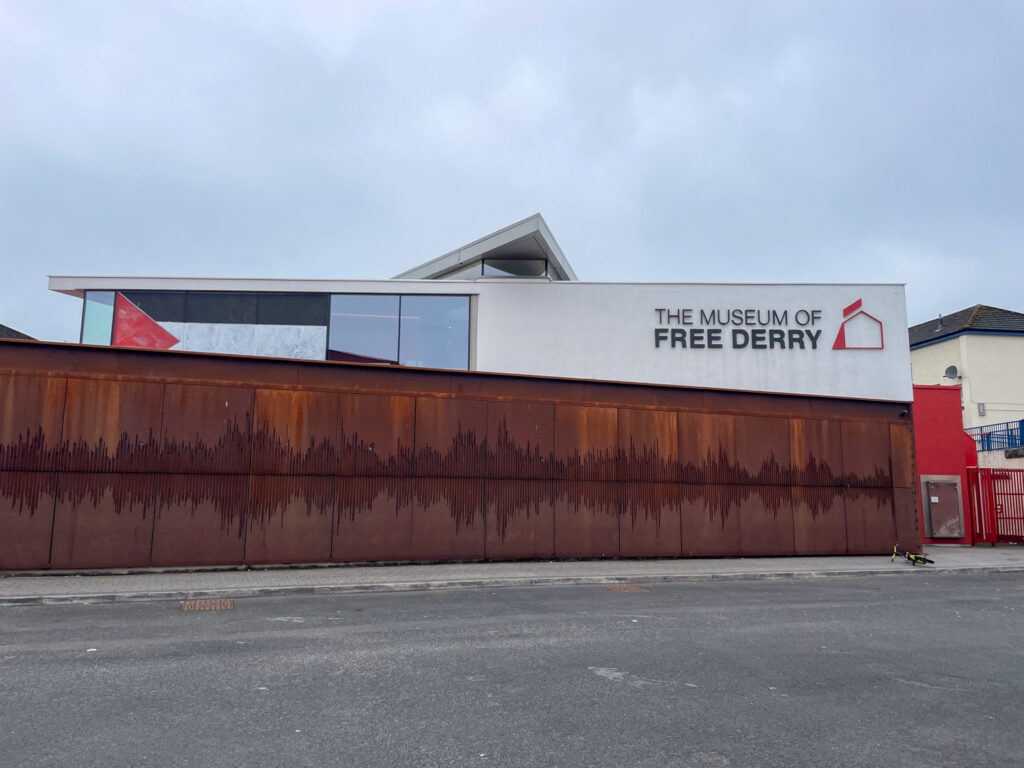
A Stroll Through the Bogside: Murals and Monuments
Bogside is the working-class neighbourhood where Bloody Sunday took place. Today, you can see Derry’s famous murals and several monuments depicting the struggles and stories of the civil rights movement and the Troubles.
When you’re in Derry, I highly recommend walking through this neighbourhood, seeking the murals and absorbing their powerful messages. If you want a more in-depth understanding of the significance behind each mural, you can join a Bogside Murals Tour.
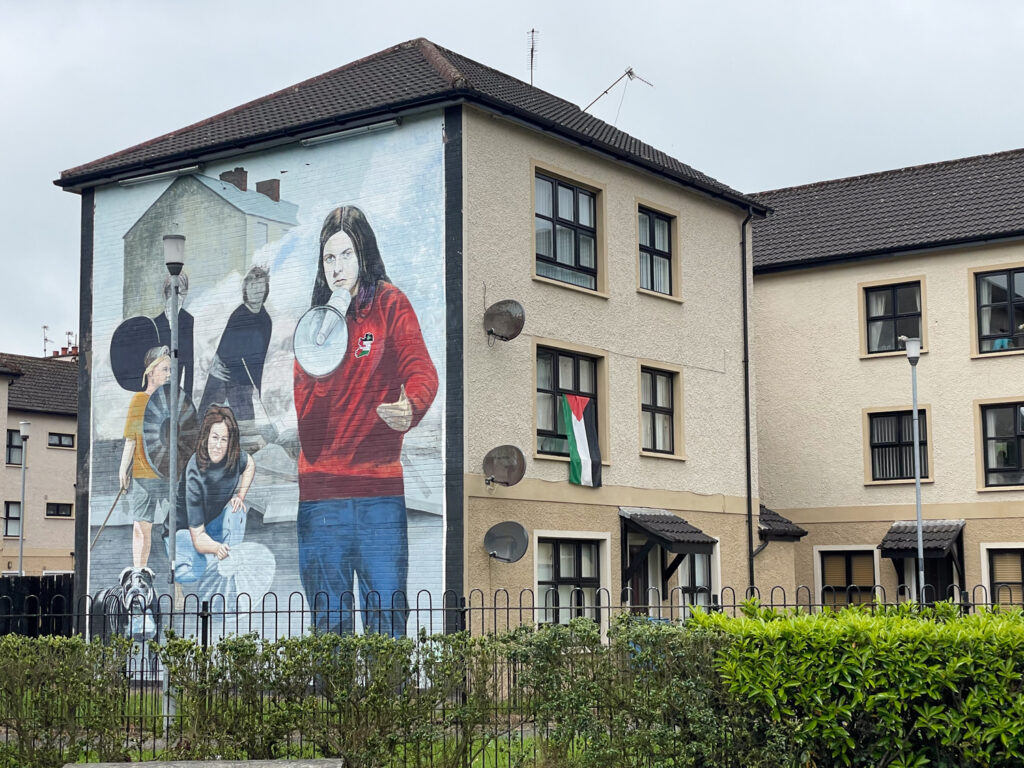
The Peacemakers Museum
The Peacemakers Museum explains how Northern Ireland transitioned from decades of violent conflict to today’s peace. The museum explores the period from August 1972 to May 2007, explaining how the conflict evolved into a peace process and the impact of both on the local community.
It also highlights the significant contributions of three Bogsiders, John Hume, Martin McGuinness, and Mitchel McLaughlin, in creating the conditions that led to the 1998 Good Friday Agreement, which provided a political framework for resolving the conflict, and eventually to the peace.
Peacemakers Museum
128 Lecky Road, Derry BT48 6NP
The Peace Bridge
The Peace Bridge, opened in 2011, symbolises reconciliation between the diverse communities of Derry. Its serpentine design wants to be a testament to triumph over adversity and represents peace by connecting both sides of the River Foyle. You can also view the Peace Bridge from the city walls.
Embracing the Spirit of Derry
In conclusion, from my visit to Derry, I learned it’s a city of incredible historical importance. It has been violently wounded in recent dark years and has been able to pick itself up and reinvent itself. There are still conflicts and contradictions that you can see even as a tourist, but I also saw a lot of resilience, creativity, and unwavering hope. Feel free to share your thoughts about Derry’s spirit in the comments below!
